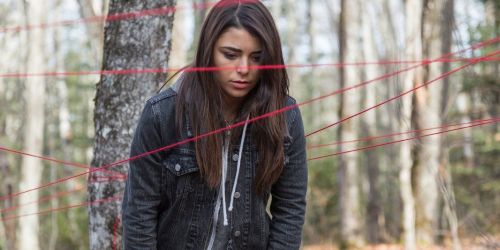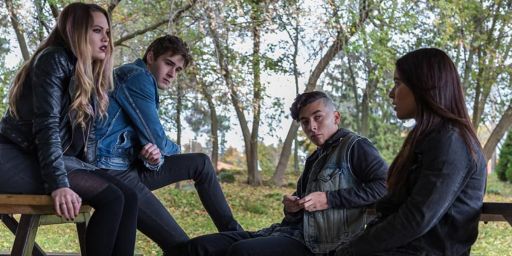In the 2017 horror drama film “Pyewacket,” directed by Adam MacDonald, the tumultuous relationship between a teenage girl and her mother is explored in the wake of a horrific family tragedy. After her father dies, Leah Reyes rapidly turns to occult activities to get away from her horrible home life with a careless, heartbroken mother. As the mother-daughter connection deteriorates, she naively participates in a summoning ritual and unintentionally sends Pyewacket, a formidable demon, into her life.
Leah is caught in a nightmare she made and fights to survive and bring things back to normal. The story of survival and complicated family connections in “Pyewacket” is intriguing but frightening, with a strong witchcraft and mystical undercurrent. By concentrating on Leah’s adolescent suffering, which serves as the plot’s foundation, the fantastical scenario is given plausibility. The nuanced depiction of the relationship between Leah and her mother and the Satanist imagery in “Pyewacket” may leave viewers wondering whether it is real or not. Explore it more thoroughly now!
Is Pyewacket a True Story?
To be clear, Pyewacket is not based on a true story. The majority of the movie’s characters and plotlines are inventions of writer/director Adam MacDonald. Nevertheless, he persisted in finding inspiration in reality no matter where he encountered it. This film, which centres on a black magic ritual, deals extensively with mysterious occult subjects. To the greatest extent possible, MacDonald intended to ensure that the implementation of the same was authentic. He devoted himself to thorough research on black magic as it applied to real-world situations as a result, spending close to a year doing so.
The central idea of the film, Pyewacket, is also based on an actual legend. The idea for this movie first came to MacDonald while she was watching William Friedkin’s 1990 movie “The Guardian,” in which a character casually mentions the word “Pyewacket.” Due to the name’s mystery, MacDonald got lost in a research rabbit hole, which immediately gave him the concept for this movie.
“Everything originated from that name. It was a very inspiring experience. Everything only matched my goals for using the occult. MacDonald discussed his writing process in an interview with HorrorXtra. “I took some elements from my own and saw the whole movie like a lightning bolt,” he claimed. It took a month to write. I had the demon-possessed feeling.
Therefore, Pyewacket’s demeanour was heavily influenced by the real-life narratives and legends associated with the witch ghost. On the other hand, the character is allowed a great deal of creative freedom to work within the plot. For instance, MacDonald used his personal worries as inspiration to picture Pyewacket as a menacing shadow in a dark room.
“Imagining something/someone “sitting” in the corner of the room by the wall and ceiling while lying in bed at night in the dark gives me chills,” the filmmaker said. This concept of the unknown inciting fear is used a few times in the film, and it has a big impact on how the horror element is handled. This intentional ambiguity-use was inspired by the Japanese horror subgenre, which influenced MacDonald’s story.
In a similar spirit, MacDonald drew inspiration from actual life for the movie’s emotional foundation. The film’s main topic revolves around Leah’s tumultuous relationship with her mother. Pyewacket’s plot is based on complex family dynamics, which makes it easy for a sizable section of the audience to relate to it. Of course, in order to carry out the same in a sincere manner, MacDonald needed a complete understanding of Leah’s personality and issues.
“I can relate to that feeling; it was like a springboard for what she was going through. As if I could relate to her feelings throughout the entire movie. In reference to Nicole Muoz’s persona, Macdonald said, “You have these tight ties, and you might just, you know, sever it. It’s not like you’re an adult with the authority to help out. Because it’s so alone, especially if Leah is anxious a lot, you just lash out in these really sudden and strong ways, you know?
The fact that “Pyewacket” borrows some of its magical elements from folklore ultimately helps it maintain its sense of realism despite taking the shape of fantasy. In a manner similar to this, the bond between Leah and her mother gives the film a genuine relatability. Thus, it explores a close-knit yet universal relationship between a child and parent that is reminiscent of reality. The Adam Macdonald-directed movie’s supernatural features, however, rapidly reveal that the plot is fictitious.


